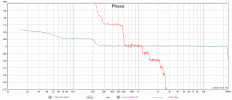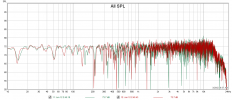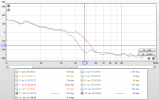It's interesting that the overall impact of the room reflections seems to be down as much as -10 dB with the Martin Logan speakers. Do you hear a more enveloping sound with the JBL speakers, or any other differences you think got to do with the different dispersion characteristics of the two speakers?
Opinion, somewhat backed by measures, and biased however you might perceive:
To me, the JBLs spread things out, like a little "out of focus". I suppose deadening the reflections would fix that, but I won't bother.
The panels give a sharp "image". Very small angular differences - like two horn players standing next to each other to one side - seem (or can easily be imagined) to be angularly differentiated.
The JBL gives a "big" image - seems stretched out in comparison - but not very deep.
The ML seem to give a narrower perspective upon switching, then that turns into something just as wide but a little more distant sounding, somehow. I forget that after a while and just enjoy the sharper perspective. I remember once trying to locate the speaker with eyes closed after spinning around to disorient myself, walking toward the panel, and bumping into it while it still sounded three feet away.
The ML will give 180 degree stereo soundfield when playing something with that content - a couple of QSound recordings come to mind. Otherwise not bounded by the speakers with proper recordings.
For best "stereo", both require "head locked in a vise". I don't see how any speaker can't require that.
One evening with Audio Buddy, listening to the JBL vs ML, we weren't even sure if the JBL were in or out of phase with each other, and had to check to be sure. The ML gave no sensation on the same material/test. With pink noise out of phase the ML are very uncomfortable to the ears (rip your ears off), the JBL, just sound even less precise.
So, for high powered (big amps are attached) or "critical listening", the Krells and MLs are fired up. For daily don't care off axis or basic TV use, the JBLs.
If the high frequencies are particularly beamy with the ML, it doesn't bother me since I'm deaf to most of them anyway.
Audio Buddy doesn't complain, and has a similar ML setup at his place (with the CLS speakers), so...



